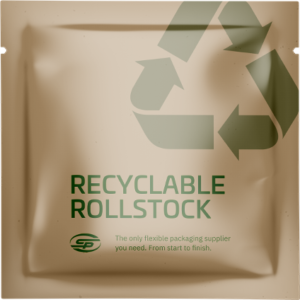Products
- Printed rollstock
- High-barrier flexible packaging
- Matte/gloss flexible packaging
- Compostable flexible packaging
- Recyclable flexible packaging
- Stick pack film laminations
- Lidding films
- Peel and reseal rollstock
- Shrink bands
- HFFS and VFFS rollstock
- Inno-Lok® pre-zippered rollstock
- Laser die-cut window rollstock
- Paper flexible packaging
- High burst strength flexible packaging
- Child-resistant flexible packaging
- Premade pouches
- Roll-fed labels
- Shrink sleeves
- Stretch sleeves
- Cold-seal packaging
- Thermoformed food trays
- Functional bags & pouches
Recyclable flexible packaging
Sustainable packaging has become an important topic. Flexible packaging exerts less of an overall impact on the environment than most other types of packaging (see “source reduction” statistics below), but a downside of flexible packaging is that much of it isn’t easily recyclable. And consumers are concerned now more than ever about what a package’s end of life should be.

For brands seeking recyclable packaging, we offer recyclable packaging film laminations made from mono-material, 100% polyethylene (PE). Clean, dry, 100% PE pouches can be recycled at store drop-off locations found at many supermarkets and grocery stores.
100% polyethylene (PE) flexible packaging provides a win/win/win solution; the environment, consumers, and brands all benefit. This flexible packaging material:
- Provides recyclability, without compromising durability or resealability.
- Exudes a distinctive look and feel that eco-conscious consumers recognize.
- Reinforces the brand image of environmentally responsible brands.
Although 100% PE flexible packaging laminations aren’t ideal for every type of product, examples of items that tend to work well in high-density PE (HDPE) pouches are:
- Snacks
- Sweeteners
- Flours
- Nuts
- Baking mixes
- Pet food
- Rice
- Pasta
- Dry goods
- Detergent packs
PE flexible packaging laminations can be further customized with moisture and/or oxygen barriers to meet performance requirements.
Flexible packaging made with post-consumer recycled (PCR) materials
For brands interested in flexible packaging created from recycled materials, we offer various options:
Polyester (PET) flexible packaging made from up to 90% post-consumer recycled resin
This looks and feels the same as PET flexible packaging made without PCR materials. There are no trade-offs in terms of barrier, and no discernible differences between PET flexible packaging made with PCR resin vs. non-PRC resin.
Polyester (PET) flexible packaging made from up to 100% post-consumer recycled resin
We are currently testing this structure to determine if there are any trade-offs between this option and other PCR options.
Polyethylene (PE) flexible packaging with up to 45% PCR resin
PE with PCR resin does look and feel a little different than non-PCR resin; there are some visual differences, as is typical with many materials made from post-consumer recycled content. But, there are no trade-offs in terms of barrier.
Flexible packaging made from renewable resources
We can provide flexible packaging rollstock made from bioplastics such as polylactic acid (PLA). PLA is derived from fermented plant starch (corn, cassava, sugarcane, or sugar beet pulp).
Industrially compostable flexible packaging
PLA films are the primary option for compostable material in flexible packaging. PLA pouches are only compostable in industrial composting facilities; they will not biodegrade in backyard composting bins.
Source reduction
Source reduction is any practice that reduces, eliminates, or prevents pollution at its source. The Environmental Protection Agency (EPA) considers source reduction the most environmentally preferred strategy.
According to the EPA, lightweighting of packaging is an example of source reduction, and source reduction can:
- Save natural resources
- Conserve energy
- Reduce pollution
- Reduce the toxicity of our waste
- Save money for consumers and businesses alike
We are experts in downgauging or “right-sizing” flexible packaging structures. We’ve also helped many leading brands convert from rigid packaging to flexible packaging, effectively reducing the source material required for each package.
Less waste in the first place
When compared to other packaging formats, flexible packaging generally:
- Consumes less energy in manufacturing and transport
- Weighs less, with a better product-to-package ratio
- Generates less greenhouse gas emissions
- Contributes less to landfill waste (even when including recycling rates of other packaging formats)
Compared to rigid plastic packaging, flexible packaging:
- Uses approximately 60% less plastic
- Requires approximately 50% less energy to produce
- Generates less CO2 emissions during production
- Results in less landfill waste through source reduction; flexible packaging represents only about 2% of municipal solid waste
- Requires fewer trucks for transportation — reducing fossil fuel consumption and CO2 emissions
For example, when a household chemical brand converted from trigger-spray bottles to trigger-spray stand-up pouches, they calculated the following reduction in fuel and greenhouse gases:
- 364,000 empty pouches could fit in one truckload.
- The same quantity of rigid bottles previously required 9 truckloads.
- The additional eight truckloads traveling 1,000 miles required an additional 2,000 gallons of fuel and emitted nine times the amount of greenhouse gases.
Let's talk flexible packaging.
Ask us your packaging questions, and we’ll see how we can help you overcome your next packaging challenge.

Sustainable Packaging
Learn more about our sustainable packaging options including: recyclable, PCR, compostable, and biopolymer usage
GreenStream Products